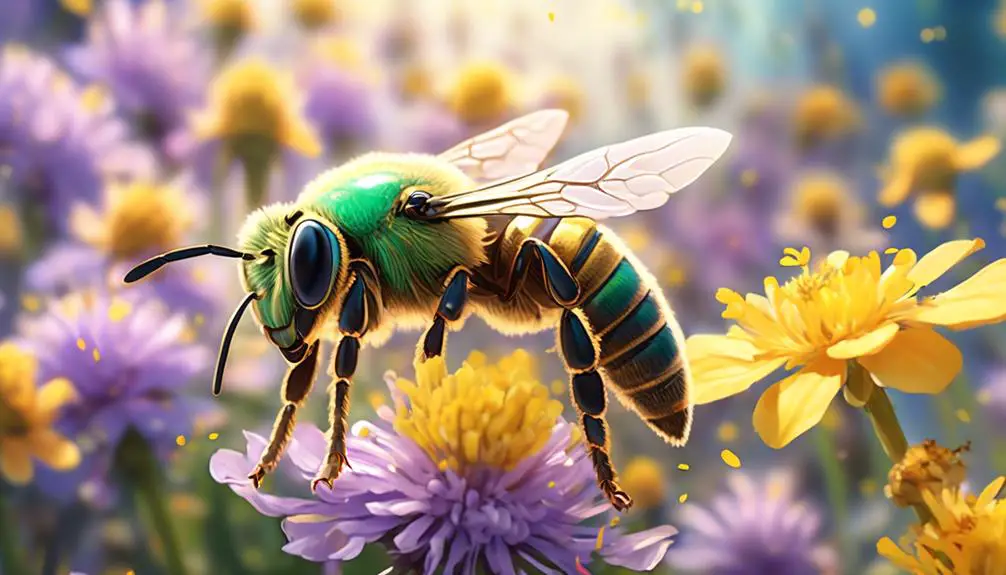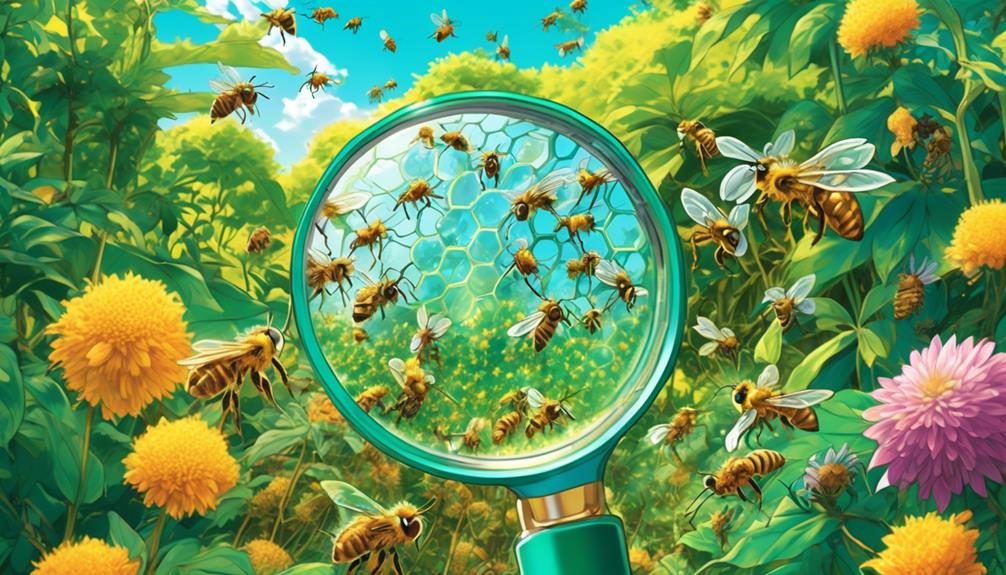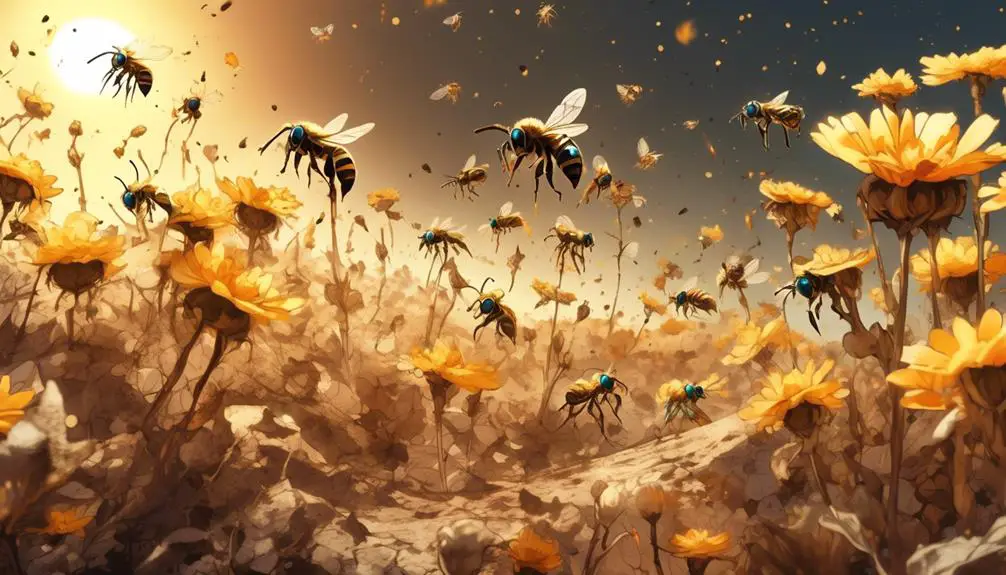Kicking up a buzz, learn why the sudden surge of sweat bees this year is more significant than you might think.

Why so Many Sweat Bees This Year
Remember Alfred Hitchcock's 'The Birds,' where birds inexplicably start attacking people? Now, picture a similar scenario, but replace the birds with sweat bees.
You've probably noticed an unusually high number of these bees buzzing around this year. While they might seem harmless, their increasing presence is something to ponder over. Sure, they're not as menacing as Hitchcock's birds, but there's more to this sudden upsurge than meets the eye.
As we embark on this exploration, you'll uncover why these tiny visitors are making such a big entrance this year. Buckle up; it's going to be an enlightening journey.
Key Takeaways
- Sweat bees are attracted to human perspiration because of the salt it contains and supplement their diet with minerals found in sweat.
- Factors such as warm, humid climates and the availability of food sources can affect sweat bee populations.
- Climate change can impact sweat bees through altered flower blooming times, changes in precipitation patterns, and milder winters.
- Sweat bees play a crucial role in ecosystem balance by acting as primary pollinators, supporting plant reproduction, and creating habitats for various species.
Understanding Sweat Bee Behavior

To fully grasp the intriguing behavior of sweat bees, you'll need to delve into their unique habits, which interestingly enough, revolve heavily around human perspiration. It's not that they're attracted to the sweat itself; instead, they're drawn to the salt it contains. Their tiny bodies are unable to extract sufficient minerals from their usual diet of nectar and pollen, so they supplement it with your salty perspiration.
The second fascinating aspect of their behavior is their non-aggressive nature. Unlike their notorious counterparts, the honeybees, sweat bees rarely sting. They're more focused on their sweat-collecting mission than on causing you harm. However, you may feel a slight pinch if you try to swat them away, a defensive reaction rather than an aggressive one.
Lastly, their nesting habits are also worth mentioning. Sweat bees are solitary creatures, each female digging her own burrow to lay eggs. It's in these underground nests that they store the nutrients collected from your sweat, ensuring the survival of the next generation. Understanding these behaviors gives you a new perspective on these often misunderstood creatures. They're not pests, but rather nature's clever engineers, turning your sweat into survival.
Factors Affecting Sweat Bee Population

While understanding their behavior sheds light on their unique relationship with humans, it's also important to consider the various factors that impact the population of sweat bees.
Firstly, let's consider environmental conditions. Sweat bees flourish in warm, humid climates. That's why you're likely to notice an increase in their numbers during summer. However, harsh winters can lead to a significant decrease in their population.
Secondly, the availability of food sources is crucial. Sweat bees feed on nectar and pollen and are attracted to human sweat due to its salt content. If there's a decline in the number of flowering plants or if human activities limit their access to sweat, you'll notice a drop in their numbers.
Furthermore, sweat bees are solitary creatures. They don't live in large colonies like honeybees, which makes them more vulnerable to predators.
Impact of Climate Change on Sweat Bees

Climate change, with its rising temperatures and altered precipitation patterns, is poised to significantly impact the survival and distribution of sweat bees. You must understand that these tiny pollinators are especially sensitive to environmental changes.
An increase in temperatures can lead to a mismatch in the timing of flower blooming and the bees' active periods. If flowers bloom earlier due to warmer springs, they may not coincide with the bees' emergence, leading to a food shortage.
Altered precipitation patterns also affect the availability of nesting sites. Sweat bees typically nest in the ground, and too much rain can flood these sites, while drought can make the soil too hard for nest building.
Conversely, milder winters may benefit certain sweat bee species by reducing their mortality during hibernation. However, this could create an imbalance in local ecosystems as the bees outcompete other pollinators.
Sweat Bees and Ecosystem Balance

In spite of their small size, sweat bees play a crucial role in maintaining equilibrium in various ecosystems, acting as primary pollinators and contributing to the biodiversity of plants. These tiny powerhouses help ensure the reproduction of many plant species by transferring pollen from male to female flower parts.
You mightn't realize it, but their work is vital for our survival, as they support the growth of fruits, vegetables, and nuts we rely on for food.
However, sweat bees' contribution isn't limited to food production. They also boost the health and diversity of natural habitats. By pollinating a variety of plants, they assist in creating habitats for countless other species, from insects to mammals. Therefore, sweat bees are intrinsic to a balanced ecosystem, making their presence beneficial.
Unfortunately, environmental changes and habitat loss are threatening sweat bee populations. As a result, ecosystems around the world are at risk.
Ways to Manage Sweat Bee Presence

Despite their ecological importance, you might find the presence of sweat bees slightly bothersome, and managing them effectively requires understanding their habits and habitats. Sweat bees are attracted to the salts in human sweat, so reducing outdoor exertion during their peak activity times—typically on hot, sunny days—can help manage their presence.
Here's a handy table to guide you:
Strategy | Details | Effectiveness |
|---|---|---|
Reduce outdoor exertion | Sweat bees are attracted to sweat, so minimize outdoor physical activity on hot, sunny days. | Medium |
Plant repellent flora | Certain plants, like citronella and marigolds, naturally repel sweat bees. | High |
Remove potential habitats | Sweat bees often nest in the ground or decaying wood. Regular yard maintenance helps. | High |
Use traps | Commercially available bee traps can be an effective last resort. | Medium to High |
Consult professionals | If a large infestation is present, a pest control professional may be necessary. | High |
Conclusion
So, you've noticed an influx of sweat bees this year. It's not just your imagination. Changing climates, along with other environmental factors, are boosting their numbers.
While they might seem a nuisance, remember they play a crucial role in our ecosystem's balance. You can manage their presence without causing harm.
Stay informed, adapt, and coexist – that's the key to sharing our world with these tiny, yet vital, pollinators.



